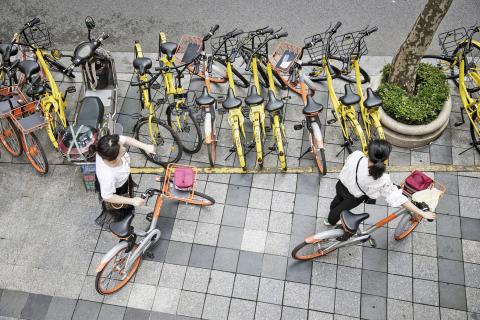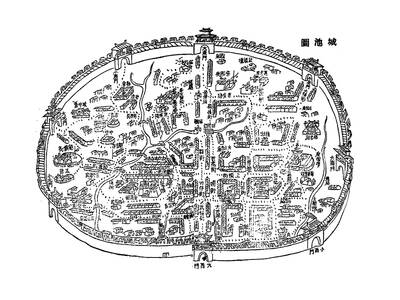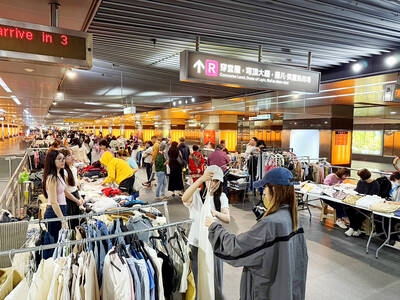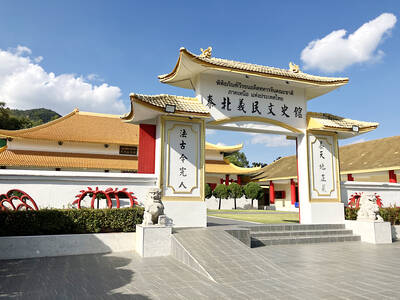Bike sharing has a lot going for it. It’s mass transit that’s ultra-cheap, burns body fat instead of fossil fuels and is adored by venture capitalists. But the business model has hit a major snag: parking.
Stringent laws against sidewalk clutter — and cultural sensibilities that are easily offended — make the problem more acute in Japanese cities than in places like Munich or Melbourne, where bicycles are piling up outside subway stations or turning up under bridges, sometimes to the dismay of neighbors and city officials.
Bike sharing took China by storm in 2016, quickly became a novel tech export and is now facing backlash even in environmentally-friendly places where you’d expect it to be embraced. That’s why the industry’s biggest players are treading lightly in Japan, a country where free-form bicycle parking is outlawed and authorities routinely haul away bikes even if it means snipping locks.

Photo: Bloomberg
Beijing Mobike Technology last month announced a partnership with the owner of Japan’s biggest messaging app, Line, to allow Line’s 71 million users to locate rental cycles though its platform. Theoretically, the deal gives Mobike a massive customer base, but so far the company has been cautious in delivering actual bicycles.
TREADING LIGHTLY
Mobike began testing its Japanese service last summer with 1,000 bikes in the out-of-the way city of Sapporo. The bikes were the same silver and orange ones Mobike deploys everywhere — with airless tires and chainless drive shafts they can run for years without maintenance — but the company was careful to tie up with local retailers, who provided space for designated parking. They also made sure to secure the approval of city government, which sent its vice mayor to pose for photos at the August launch ceremony.
“Whether you have a working relationship with local governments makes all the difference,” Chris Martin, Mobike’s vice president in charge of international expansion said in an interview.
Mobike last year raised US$600 million from investors including Chinese Internet giant Tencent and Silicon Valley’s Sequoia Capital. The company already has 8 million bikes in 200 cities worldwide, including Berlin, Milan and Washington DC, with plans to double its users by the middle of this year. In most markets, it’s left to riders to figure out how to park responsibly.
SIDEWALK MENACE
Roads everywhere are some of the most heavily regulated spaces, but Japan also has stringent rules for its sidewalks. In the early 1980s the number of illegally parked and abandoned bicycles peaked near one million, according to Japan’s Cabinet Office, which tracks such things.
Authorities responded with a nationwide campaign, hauling off bikes for recycling or shipping them to developing countries like Vietnam and Myanmar. Since then municipalities have invested in enough paid parking to accommodate almost 4 million bikes. Tokyo and Kyoto even have automated garages, where robotic arms whisk their cargo into underground silos.
The experience of Docomo Bikeshare, a unit of Japan’s biggest mobile phone carrier, shows that cities can be willing partners if the business is done neatly. Since starting in 2011, Docomo has gotten municipalities to share the cost of purchasing its bicycles, which are battery-boosted and can run as much as US$1,500. Tokyo’s Minato ward, for example, supported the service in order to fill a gap in its transit grid, the last kilometer between the nearest train station and home.
TIDY MODEL
Docomo’s riders are forced to park at the company’s own docking stations, which are equipped with sensors to make sure the bikes are returned properly. It’s a tidy approach that’s kept the business limited to fewer than 7,000 bicycles spread across 24 cities — far short of the numbers needed to qualify as mass transit.
“Japan is special in that you have to start by thinking about what to avoid, things like having bikes where they’re not supposed to be,” said Kouichi Saitou, an executive at Docomo Bikeshare. “You can’t just expand willy-nilly.’’
In theory, that leaves room for competitors like Mercari, operator of a hugely popular Japanese flea-market app which in September announced plans to start bike-sharing early this year.
“We’re looking to build something that functions on the scale of public transport,” said Ryosuke Matsumoto, the Mercari executive in charge of the project.
While he was vague on the details, Matsumoto said Mercari might try to leverage the point system its customers are already using on its flea-market app to encourage good cycling manners. Providing designated parking, Docomo-style, isn’t the answer because that model is impossible to scale, he said. “If users don’t always see one of your bikes nearby, it just doesn’t work.”
BICYCLE BURIAL
Scale isn’t the problem in China, where some 70 bike-sharing companies have deployed around 16 million cycles. There, the problem is the mess. Pictures circulated on social medial of a towering pile of broken bikes in Shenzhen and a massive bike burial mound in Xiamen have become damning symbols of the clutter.
The potential for bad optics convinced Japanese entrepreneur Keishi Kameyama, the billionaire owner of media platform DMM.com, to abandon his plans for a bike-sharing service in November. Kameyama’s businesses include a controversial porn Web site, but he says bike sharing was too risky for him.
“We didn’t want people to curse DMM every time they saw one of our bikes,” he said.
Xue Ding, co-founder of Chinese bike-sharing giant Ofo, says keeping things tidy and still getting the scale needed is a hard balancing act. Ofo has ambitious plans to put 20 million bikes in 20 countries but, like everyone else, it’s going slow in Japan. The company in August announced a partnership with SoftBank Group, the Japanese telecom operator run by Masayoshi Son, the country’s most audacious tech investor. The plan was to start service in Osaka and Tokyo as early as September, but nothing has happened yet.
“If you can only park in specific places, then that’s going back to the previous era of bike sharing,” Xue said. “Japan may begin with this extreme, just as China started with the other extreme of no parking restrictions. Ultimately, the balance is somewhere in between.”
— Grace Huang contributed to this report

May 26 to June 1 When the Qing Dynasty first took control over many parts of Taiwan in 1684, it roughly continued the Kingdom of Tungning’s administrative borders (see below), setting up one prefecture and three counties. The actual area of control covered today’s Chiayi, Tainan and Kaohsiung. The administrative center was in Taiwan Prefecture, in today’s Tainan. But as Han settlement expanded and due to rebellions and other international incidents, the administrative units became more complex. By the time Taiwan became a province of the Qing in 1887, there were three prefectures, eleven counties, three subprefectures and one directly-administered prefecture, with

It’s an enormous dome of colorful glass, something between the Sistine Chapel and a Marc Chagall fresco. And yet, it’s just a subway station. Formosa Boulevard is the heart of Kaohsiung’s mass transit system. In metro terms, it’s modest: the only transfer station in a network with just two lines. But it’s a landmark nonetheless: a civic space that serves as much more than a point of transit. On a hot Sunday, the corridors and vast halls are filled with a market selling everything from second-hand clothes to toys and house decorations. It’s just one of the many events the station hosts,

Among Thailand’s Chinese Nationalist Party (KMT) villages, a certain rivalry exists between Arunothai, the largest of these villages, and Mae Salong, which is currently the most prosperous. Historically, the rivalry stems from a split in KMT military factions in the early 1960s, which divided command and opium territories after Chiang Kai-shek (蔣介石) cut off open support in 1961 due to international pressure (see part two, “The KMT opium lords of the Golden Triangle,” on May 20). But today this rivalry manifests as a different kind of split, with Arunothai leading a pro-China faction and Mae Salong staunchly aligned to Taiwan.

Two moves show Taichung Mayor Lu Shiow-yen (盧秀燕) is gunning for Chinese Nationalist Party (KMT) party chair and the 2028 presidential election. Technically, these are not yet “officially” official, but by the rules of Taiwan politics, she is now on the dance floor. Earlier this month Lu confirmed in an interview in Japan’s Nikkei that she was considering running for KMT chair. This is not new news, but according to reports from her camp she previously was still considering the case for and against running. By choosing a respected, international news outlet, she declared it to the world. While the outside world